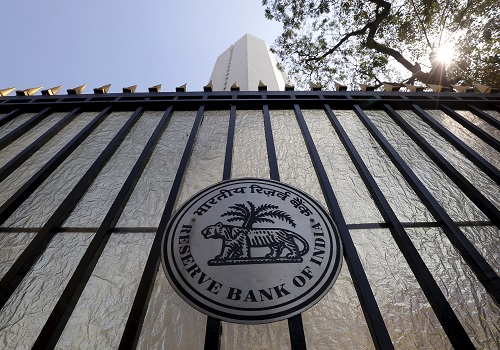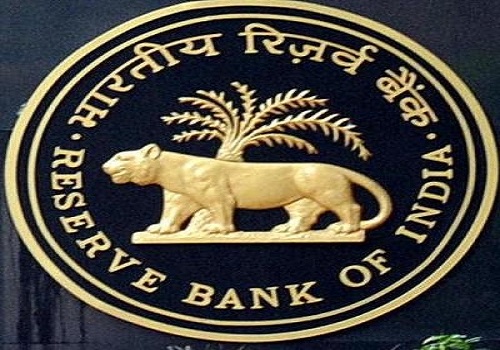Crudeoil trading range for the day is 6734-7010 - Kedia Advisory

Follow us Now on Telegram ! Get daily 10 - 12 important updates on Business, Finance and Investment. Join our Telegram Channel
Gold
Gold prices saw a notable uptick yesterday, gaining 1.13% to settle at 67701 as investors digested a blend of fresh economic indicators and mixed signals from Federal Reserve officials. The impending US PCE index price report loomed over market sentiment, contributing to a cautious atmosphere. Fed Governor Christopher Waller's cautionary remarks about potential interest rate cuts due to robust inflation added to the market's apprehension. Currently, there's a 64% probability priced in for a rate reduction in June, suggesting lingering uncertainty. Geopolitical tensions in Eastern Europe and the Middle East remained supportive of gold demand, acting as a bulwark against downward pressure. Additionally, the final GDP estimate for Q4 2023 in the US exceeded expectations, with a robust expansion of 3.4% reported by the Bureau of Economic Analysis. However, India's gold imports are expected to plummet by over 90% in March compared to February, marking the lowest level since the onset of the COVID-19 pandemic. This substantial reduction is attributed to record-high prices denting demand and banks curtailing imports. From a technical standpoint, the market exhibited signs of fresh buying, with open interest rising by 11.1% to settle at 23487. Prices surged by 757 rupees, indicating bullish momentum. Support for gold is seen at 67190, with a potential dip to 66675 levels if breached. On the upside, resistance is anticipated around 68040, and a break above could lead to a test of 68375.
Trading Ideas:
* Gold trading range for the day is 66675-68375.
* Gold prices hovering at all-time highs, as investors assessed fresh economic data and mixed signals from Fed officials.
* The latest data showed the U.S. economy performing far better than expected in the final three months of 2023.
* The final estimate of fourth-quarter GDP showed that the U.S. economy expanded by 3.4%.
Silver
Silver's performance exhibited a modest uptick of 0.52%, settling at 75048, as investors sought refuge in the safe-haven metal amidst escalating geopolitical tensions. Fed Governor Christopher Waller's remarks, emphasizing a cautious approach towards interest rate cuts in light of recent economic data, added to the market's sentiment. Atlanta Fed President Raphael Bostic's revised projection of a single quarter-point cut instead of two further shaped investor expectations regarding monetary policy. The upward revision of US GDP growth for Q4 to 3.4% and unexpected decline in initial claims underscored the resilience of the economy. Moreover, the housing market showed signs of stabilization, with pending home sales rising for the second consecutive month according to the National Association of Realtors (NAR) report. However, year-on-year comparisons indicated a slight decline in signed contracts, reflecting lingering challenges in the sector. Amidst these developments, the University of Michigan's consumer sentiment index was revised higher for March 2024, reaching its highest level since July 2021. While inflation expectations were revised slightly lower, consumer sentiment remained buoyant, indicating underlying confidence in the economy's trajectory. From a technical standpoint, silver experienced short covering, with a drop in open interest by -0.7% alongside a price increase of 386 rupees. Support levels are identified at 74505, potentially testing 73960, while resistance lies at 75445, with a potential breakthrough targeting 75840.
Trading Ideas:
* Silver trading range for the day is 73960-75840.
* Silver gains amid concerns about geopolitical tensions.
* Fed’s Waller stressed that recent economic data would warrant a delay or a reduced amount of interest rate cuts.
* The U.S. housing market shows further signs of stabilization as potential home buyers creep back into the market.
Crude oil
Crude oil prices surged by 1.96% yesterday, settling at 6909, driven by investor anticipation of tighter supplies amidst expectations that the OPEC+ producer alliance would maintain current production cuts. Geopolitical tensions added to market apprehensions, raising concerns about potential supply disruptions. However, OPEC+ is unlikely to alter its oil output policy until a comprehensive ministerial meeting scheduled for June. The IEA revised its demand forecast upward for the fourth time since November, while also tightening its supply outlook due to ongoing disruptions in Red Sea shipping. Additionally, Mexican state energy company Pemex reported its crude oil production in February plummeted to its lowest level in 45 years, significantly below the targets set by President Andres Manuel Lopez Obrador. Pemex's output averaged 1.55 million barrels per day (bpd) in February, highlighting challenges in meeting production goals amidst governmental support initiatives. On the flip side, U.S. crude oil and gasoline inventories unexpectedly increased last week, driven by a surge in crude imports and sluggish gasoline demand, according to the EIA. Crude inventories rose by 3.2 million barrels to 448.2 million barrels, indicating a potential oversupply situation in the market. From a technical perspective, the market witnessed a surge in open interest by 100.74% to settle at 5964, accompanied by a price increase of 133 rupees. Crude oil is currently finding support at 6821, with a potential downside test at 6734. Resistance is anticipated at 6959, and a breach above could lead to a test of 7010.
Trading Ideas:
* Crudeoil trading range for the day is 6734-7010.
* Crude oil prices rose as investors anticipated tighter supplies.
* Increased geopolitical risk has raised expectations of possible supply disruption.
* OPEC+ producer alliance is widely expected to stay the course on its current production cuts.
Natural gas
Natural gas prices saw a notable uptick of 1.45%, settling at 146.5, driven by forecasts of higher demand over the next two weeks. This increase in demand comes amidst a backdrop of reduced output, with several energy firms scaling back drilling activities and delaying well completions, leading to a 3% decrease in output over the past month. In addition to supply-side dynamics, the spot market witnessed mild weather conditions and ample renewable power supplies in the US West, contributing to record-low electric prices in California and Arizona. Despite these favorable conditions, US utilities withdrew 36 billion cubic feet (bcf) of gas from storage during the week ended March 22, surpassing market expectations and highlighting sustained demand. However, gas stockpiles remain robust, currently standing at 2.296 trillion cubic feet (tcf), significantly higher than last year and above the five-year historical average. Despite this surplus, gas output in the Lower 48 US states has declined, with March averaging 100.2 billion cubic feet per day (bcfd), down from 104.1 bcfd in February. Looking ahead, meteorologists anticipate warmer-than-normal weather across the Lower 48 through April 12, which could further influence demand dynamics in the natural gas market. From a technical standpoint, the market experienced short covering, with a drop in open interest by -5.45% alongside a price increase of 2.1 rupees. Support levels are identified at 143.1, potentially testing 139.6, while resistance lies at 149, with a potential breakthrough targeting 151.4.
Trading Ideas:
* Naturalgas trading range for the day is 139.6-151.4.
* Natural gas rose on forecasts for higher demand over the next two weeks than previously expected.
* Output was already down by around 3% over the past month as several energy firms, delayed well completions
* US utilities pulled 36 billion cubic feet (bcf) of gas from storage during the week ended March 22
Copper
Copper prices experienced a modest uptick of 0.21% yesterday, settling at 760.65, largely driven by China's top copper smelters proposing a 5-10% production cut in response to tight raw material supplies. This move underscores concerns over the availability of copper, a crucial component in various industries. Despite ongoing challenges in Chinese manufacturing, including a projected sixth consecutive month of contraction in March, signs of a slower pace of decline indicate potential resilience in the face of economic headwinds. Notably, copper output in Chile, the world's leading producer, surged by 9.95% year-on-year in February, reaching 420,242 metric tons according to the country's INE statistics agency. However, despite this increase, copper inventories in Chinese warehouses, although showing a weekly decline for the first time since December, remain elevated, reflecting strong domestic production and imports. The anticipation of potential supply cuts in China has led to increased speculative activity in Comex copper futures, with speculators boosting their long positions to the highest level since May 2021, according to data from the U.S. Commodity Futures Trading Commission. From a technical standpoint, the market is experiencing short-covering, as evidenced by a drop in open interest by -1.23% to settle at 4353, alongside a marginal price increase of 1.6 rupees. Copper is currently finding support at 758, with a possible test of 755.2 if this level is breached. On the upside, resistance is expected at 763.9, with a potential breakout leading to a test of 767.
Trading Ideas:
* Copper trading range for the day is 755.2-767.
* Copper gains as China's top copper smelters proposal of a 5-10% production cut.
* Chinese manufacturing activity is likely to have contracted for a sixth straight month in March.
* Copper output in Chile, grew 9.95% year-on-year in February to 420,242 metric tons.
Zinc
Zinc prices saw a marginal uptick of 0.09%, settling at 216.95, influenced by a significant drop in China's smelter output and tight zinc concentrate raw material supply post-holiday. This supply constraint led some companies to delay production resumption, contributing to a slight increase in domestic refined zinc production in March, albeit with a year-on-year decrease. Market sentiment received a boost following hawkish remarks from Federal Reserve officials, which tempered expectations of interest rate cuts amid persistent inflationary pressures. Additionally, disruptions in zinc production globally further supported prices. Glencore's suspension of operations at its McArthur River zinc and lead mine in Australia, along with Volcan's suspension of three mines in Peru, underscored supply challenges in the market. Moreover, delays in the start of the Russian zinc mine Ozernoye and the suspension of Europe's largest zinc mine, Tara, added to the supply constraints. From a technical standpoint, the market experienced short covering, with a drop in open interest by -2.14% alongside a minor price increase of 0.2 rupees. Support levels are identified at 216.1, potentially testing 215.1, while resistance lies at 217.9, with a potential breakthrough targeting 218.7. These technical parameters offer crucial insights for traders, indicating potential entry and exit points amidst evolving market conditions.
Trading Ideas:
* Zinc trading range for the day is 215.1-218.7.
* Zinc gains as the output of China's smelters dropped significantly.
* Domestic refined zinc production in March 2024 likely to decrease 8.78% year-on-year.
* Global zinc market moved to a surplus of 58,700 metric tons in January - ILZSG
Aluminium
Aluminium prices recorded a modest gain of 0.48% yesterday, closing at 208.7, driven by concerns surrounding the sluggish recovery in production in China's Yunnan province, a significant aluminium-producing region. This uncertainty in supply dynamics contributed to market apprehensions, especially amidst growing expectations of an interest rate cut by the European Central Bank and escalating tensions between Russia and Ukraine, which elevated commodity market sentiments. Fundamentally, there are expectations for increased production in May, but the drought situation in Yunnan introduces a level of uncertainty. China's aluminium output in February saw a notable increase of 7.81% year-on-year, signaling resilience in production despite challenges. In February, downstream aluminium processing companies experienced closures or production reductions due to the Chinese New Year holidays. However, domestic aluminium smelters maintained steady operations, except for an aluminium smelter in Inner Mongolia which was still in the process of resuming production after a power outage. This disruption is expected to impact output in March. On the international front, a Japanese aluminium buyer agreed to a substantial premium of $145 per metric ton over the benchmark price for shipments in April to June, marking a notable increase of 61% from the current quarter. From a technical perspective, the market is witnessing fresh buying momentum, with a 3.9% increase in open interest to settle at 3520, alongside a marginal price uptick of 1 rupee. Aluminium is currently finding support at 207.6, with a potential downside test at 206.5. Resistance is anticipated at 209.4, with a possible breakout leading to a test of 210.1.
Trading Ideas:
* Aluminium trading range for the day is 206.5-210.1.
* Aluminium gains over concerns over slow recovery in production in China's Yunnan.
* There are expectations for an increase in production in May, but the drought situation in Yunnan may bring uncertainty.
* China's aluminium output was 3.333 million mt in February, up 7.81% YoY.
Cotton
Cotton candy prices experienced a slight decline of -0.13%, settling at 62000, driven by factors such as upward revisions in production estimates by key organizations like the Cotton Association of India (CAI) and Cotton Corporation of India (CCI). Both CAI and CCPC raised their crop production estimates for the current season, contributing to increased supply expectations for the natural fiber. Additionally, Cotton Australia's upward revision of production estimates further added to the oversupply concerns, exerting downward pressure on prices. Internationally, the US witnessed lower production and ending stocks projections for the current cotton season, while global supply and demand estimates for 2023/24 indicated higher production, consumption, and trade, albeit with lower ending stocks. The Southern India Mills’ Association (SIMA) cautioned textile mills against panic-buying, noting recent price hikes in domestic cotton prices. This increase in prices prompted concerns about decreased demand for exports as domestic prices approach international levels. Technically, the cotton candy market underwent long liquidation, evidenced by a drop in open interest by -2.06% alongside a price decrease of -80 rupees. Support levels are identified at 61820, potentially testing 61640, while resistance lies at 62200, with a potential breakthrough targeting 62400. These technical parameters offer crucial insights for traders, indicating potential entry and exit points amidst evolving market conditions. Traders remain vigilant of supply-demand dynamics and technical indicators to navigate price movements and identify strategic opportunities in the cotton market.
Trading Ideas:
* Cottoncandy trading range for the day is 61640-62400.
* Cotton dropped as CAI revised production estimates upwards to 309.70 lakh bales.
* CCPC raised crop production for the current season to 323.11 lakh bales
* Cotton Australia raised its estimate for Australian production this year to "at least" 4.5 million bales
* In Rajkot, a major spot market, the price ended at 29071.7 Rupees dropped by -0.33 percent.
Turmeric
Turmeric prices saw a decline of -1.62% yesterday, settling at 17138, primarily due to profit booking after being buoyed by below-normal supplies and active festive demand. The impact of lower production is evident in reduced arrival pace compared to the previous year, indicating supply tightness that may prompt stockists to buy at every price dip. Turmeric typically sees higher prices during March due to festive buying, and with several festivals approaching and the wedding season commencing, demand is expected to remain robust. Production is forecasted to drop by about 14% year-on-year due to lower cultivation area and tumbling yields. Despite lower production, turmeric exports during April-January 2024 dropped by 3.52% compared to the same period in 2023. However, there was a slight increase in exports from December 2023 to January 2024. Turmeric imports during April-January 2024 decreased by 22.34% compared to the previous year, but showed a rise from December 2023 to January 2024. In the major spot market of Nizamabad, prices ended slightly lower, indicating some local market dynamics influencing price movements. Technically, the market is witnessing long liquidation, with a drop in open interest by -3.67% to settle at 13515, alongside a significant price decrease of -282 rupees. Turmeric is currently finding support at 16764, with a potential downside test at 16392. Resistance is likely at 17544, with a breakout potentially leading to a test of 17952.
Trading Ideas:
* Turmeric trading range for the day is 16392-17952.
* Turmeric dropped on profit booking after prices seen supported amid below normal supplies
* Festivals ahead in coming months and commencement of wedding season demand is likely to keep buyers engage.
* Production is likely to be dropped by about 14% Y-o-Y due to lower area under turmeric.
* In Nizamabad, a major spot market, the price ended at 16658.9 Rupees dropped by -0.23 percent.
Jeera
Jeera prices faced a decline of -1.09%, settling at 23600, driven by the anticipation of increased arrivals putting pressure on the market. The influx of 10000 to 12000 bags of jeera daily in Rajkot Mandi, coupled with higher production estimates in major cumin-producing regions like Gujarat and Rajasthan, has led to an imbalance between supply and demand. Favorable weather conditions and expanded sowing areas in these regions have resulted in a record-breaking production estimate of 4.08 lakh tonnes in Gujarat, marking a significant increase from previous years. Despite expectations of increased exports due to higher production, exports during Apr-Jan 2024 witnessed a decline of 25.33% compared to the same period last year. However, January 2024 showed a notable increase in exports compared to December 2023 and January 2023, indicating potential shifts in export dynamics. From a technical standpoint, the jeera market experienced long liquidation, with a drop in open interest by -2.2% alongside a price decrease of -260 rupees. Support levels are identified at 23430, potentially testing 23270, while resistance lies at 23740, with a potential breakthrough targeting 23890. These technical parameters provide valuable insights for traders, indicating potential entry and exit points amidst evolving market conditions. Traders remain attentive to supply-demand dynamics and technical indicators to navigate price movements and identify strategic opportunities in the jeera market.
Trading Ideas:
* Jeera trading range for the day is 23270-23890.
* Jeera dropped as there is a possibility of further increase in arrivals pressure in the market.
* There will be a huge increase in cumin exports, which will reach about 14-15 thousand tonnes in February 2024.
* New arrivals have started in Gujarat since last 20-25 days and new arrivals have started in Rajasthan also since last 15 days.
* In Unjha, a major spot market, the price ended at 25906.7 Rupees dropped by -0.55 percent.
Views express by all participants are for information & academic purpose only. Kindly read disclaimer before referring below views. Click Here For Disclaimer












 320-x-100_uti_gold.jpg" alt="Advertisement">
320-x-100_uti_gold.jpg" alt="Advertisement">










